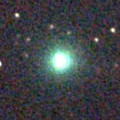
|
It brightened very rapidly. Now it is very bright as 8.9 mag (Sept. 11, Chris Wyatt). It stays bright as 8-9 mag until October. The condition is bad in this apparition. In the Southern Hemisphere, it stays observable after this while the comet will be fading. But it stays locating low. It is not observable after this in the Northern Hemisphere.
Date(TT) R.A. (2000) Decl. Delta r Elong. m1 Best Time(A, h)
Oct. 2 10 39.55 -22 24.3 1.857 1.157 33 8.7 4:31 (293, -6)
Oct. 9 11 4.47 -27 16.7 1.896 1.208 34 8.9 4:37 (298, -7)
|
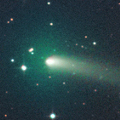
|
Now it is bright as 10.4 mag (Oct. 1, Osamu Miyazaki). It will brighten up to 9 mag, and will be observable in good condition in winter.
Date(TT) R.A. (2000) Decl. Delta r Elong. m1 Best Time(A, h)
Oct. 2 5 3.35 21 41.1 0.495 1.272 111 10.4 4:20 ( 0, 77)
Oct. 9 5 35.06 23 16.1 0.468 1.248 111 10.1 4:24 ( 0, 78)
|
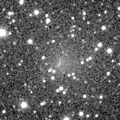
|
Now it is bright as 11.7 mag (Sept. 21, Thomas Lehmann). It is observable at 10 mag in good condition from October to December. In the Northern Hemisphere, it locates somewhat low at the high light.
Date(TT) R.A. (2000) Decl. Delta r Elong. m1 Best Time(A, h)
Oct. 2 18 47.20 -27 43.0 0.898 1.365 91 10.6 19:06 ( 15, 25)
Oct. 9 19 13.82 -29 33.9 0.939 1.377 90 10.3 18:57 ( 13, 24)
|
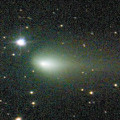
|
Now it is bright as 11.0 mag (Sept. 28, Osamu Miyazaki). It stays observable at 10-11 mag in excellent condition from summer to autumn.
Date(TT) R.A. (2000) Decl. Delta r Elong. m1 Best Time(A, h)
Oct. 2 6 3.99 16 6.2 1.167 1.636 97 10.3 4:31 (326, 68)
Oct. 9 6 17.28 15 7.7 1.130 1.648 101 10.3 4:37 (339, 69)
|
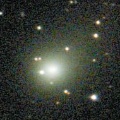
|
Now it is 10.8 mag (Sept. 28, Osamu Miyazaki). It stays bright as 10 mag until spring for a long time. In the Northern Hemisphere, it stays observable in good condition for a long time. In the Southern Hemisphere, it locates extremely low until November.
Date(TT) R.A. (2000) Decl. Delta r Elong. m1 Best Time(A, h)
Oct. 2 7 30.87 43 2.4 3.676 3.668 81 10.8 4:31 (243, 62)
Oct. 9 7 36.27 42 27.7 3.565 3.653 87 10.7 4:37 (243, 67)
|
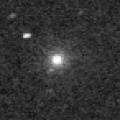
|
It was observed at 9-10 mag from late July to early August. Now it is not observable. It will appear in the morning sky in December, but it will be fainter than 15 mag at that time.
Date(TT) R.A. (2000) Decl. Delta r Elong. m1 Best Time(A, h)
Oct. 2 12 49.61 3 28.0 2.185 1.203 8 11.5 19:06 (101,-10)
Oct. 9 13 10.05 0 13.6 2.281 1.295 7 11.9 18:57 ( 98,-12)
|
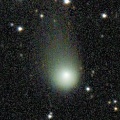
|
Now it is 11.7 mag (Sept. 29, Osamu Miyazaki). It is expected to be observable at 5-6 mag for a long time from 2022 to 2023. In the Northern Hemisphere, it is not observable at the high light from 2022 autumn to 2023 summer. In the Southern Hemisphere, it stays low for a while. But it will be observable in good condition at the high light.
Date(TT) R.A. (2000) Decl. Delta r Elong. m1 Best Time(A, h)
Oct. 2 16 59.96 26 13.6 5.432 5.195 71 11.8 19:06 ( 88, 52)
Oct. 9 17 2.24 24 50.8 5.441 5.134 67 11.8 18:57 ( 89, 49)
|
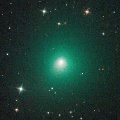
|
Now it is very bright as 10.9 mag (Sept. 8, Chris Wyatt). It will be fading after this. In the Northern Hemisphere, it will be getting lower gradually in the evening. In the Southern Hemisphere, it stays observable in good condition for a while.
Date(TT) R.A. (2000) Decl. Delta r Elong. m1 Best Time(A, h)
Oct. 2 16 19.15 -24 13.8 2.636 2.277 58 11.9 19:06 ( 48, 12)
Oct. 9 16 34.03 -25 45.8 2.734 2.313 55 12.1 18:57 ( 47, 11)
|
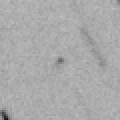
|
Now it is 14.6 mag (Sept. 11, Chris Wyatt). It will brighten rapidly up to 9 mag in winter. It will be observable in good condition. In the Southern Hemisphere, it is observable in excellent condition. In the Northren Hemisphere, it is not observable until November.
Date(TT) R.A. (2000) Decl. Delta r Elong. m1 Best Time(A, h)
Oct. 2 23 27.38 -58 42.4 1.233 1.904 116 12.9 22:41 ( 0, -4)
Oct. 9 23 17.94 -57 57.3 1.220 1.852 112 12.6 22:05 ( 0, -3)
|
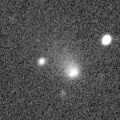
|
Now it is 13.1 mag (Sept. 20, Ken-ichi Kadota). It will approach to Earth down to 0.2 a.u. in December, and it is expected to brighten up to 4 mag. In the Northern Hemisphere, it stays observable in good condition for a long time until December while the comet is brightening gradually, although it became extremely low temporarily in September. In the Southern Hemisphere, it is not observable until mid December.
Date(TT) R.A. (2000) Decl. Delta r Elong. m1 Best Time(A, h)
Oct. 2 11 19.45 37 37.2 2.420 1.843 44 13.1 4:31 (237, 19)
Oct. 9 11 25.94 36 53.9 2.240 1.740 48 12.7 4:37 (241, 24)
|
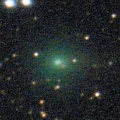
|
It brightened very rapidly up to 10.7 mag in July (July 20, Osamu Miyazaki). Now it is fading. It has already faded down to 13.3 mag (Sept. 19, Seiichi Yoshida). It stays observable in the morning sky for a long time.
Date(TT) R.A. (2000) Decl. Delta r Elong. m1 Best Time(A, h)
Oct. 2 8 10.57 26 22.0 1.499 1.487 69 13.2 4:31 (270, 51)
Oct. 9 8 23.65 26 8.7 1.500 1.552 73 13.7 4:37 (274, 55)
|
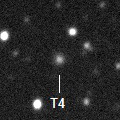
|
Now it is 14.6 mag (July 12, Chris Wyatt). It is expected to brighten up to 11.5 mag in 2022. In the Southern Hemisphere, it stas observable in good condition for a long time, although it became extremely low temporarily from August to September. In the Northern Hemisphere, it is not observable until November.
Date(TT) R.A. (2000) Decl. Delta r Elong. m1 Best Time(A, h)
Oct. 2 10 43.56 -24 7.5 5.523 4.718 33 13.3 4:31 (294, -8)
Oct. 9 10 51.14 -24 32.5 5.472 4.694 35 13.3 4:37 (298, -3)
|
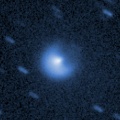
|
Major outburst occured on Sept. 25. Now it is very bright as 11.0 mag (Oct. 1, Osamu Miyazaki).
Date(TT) R.A. (2000) Decl. Delta r Elong. m1 Best Time(A, h)
Oct. 2 4 57.75 31 54.5 5.473 5.918 111 13.5 4:16 ( 0, 87)
Oct. 9 4 57.44 32 2.1 5.376 5.920 118 13.4 3:48 ( 0, 87)
|

|
It brightened up to 12.3 mag from spring to summer (June 15, Marco Goiato). Now it is fading. It has already faded down to 13.8 mag (Sept. 8, Chris Wyatt). Now it is not observable. It will be observable again at 14 mag in November in the Northern Hemisphere, or in January in the Southern Hemisphere.
Date(TT) R.A. (2000) Decl. Delta r Elong. m1 Best Time(A, h)
Oct. 2 13 54.94 -2 56.3 4.615 3.696 20 13.8 19:06 ( 87, -1)
Oct. 9 13 58.05 -2 37.8 4.676 3.723 15 13.8 18:57 ( 89, -4)
|
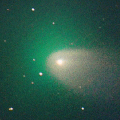
|
It brightened up to 9.7 mag in June (June 4, Michael Jager). Now it is fading. It has already faded down to 14.1 mag (Sept. 11, Chris Wyatt). In the Southern Hemisphere, it stays observable in excellent condition for a long time. In the Northern Hemisphere, it becomes extremely low after this.
Date(TT) R.A. (2000) Decl. Delta r Elong. m1 Best Time(A, h)
Oct. 2 23 17.82 -47 14.2 1.139 1.914 126 14.6 22:32 ( 0, 8)
Oct. 9 23 15.86 -45 23.4 1.230 1.968 123 15.0 22:03 ( 0, 10)
|
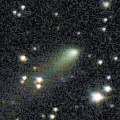
|
Now it is 14.5 mag (Sept. 22, Thomas Lehmann). It stays 14 mag until October, and it is observable in good condition. It locates somewhat low in the Southern Hemisphere.
Date(TT) R.A. (2000) Decl. Delta r Elong. m1 Best Time(A, h)
Oct. 2 16 10.87 20 34.2 2.651 2.297 58 14.8 19:06 ( 88, 40)
Oct. 9 16 8.44 19 36.5 2.749 2.300 53 14.9 18:57 ( 90, 35)
|

|
Now it is 14.9 mag (Sept. 6, ATLAS-MLO, Mauna Loa). It stays 13-14 mag from 2020 to 2021. It will be observable in good condition after this in the Southern Hemisphere. It locates low in the Northern Hemisphere.
Date(TT) R.A. (2000) Decl. Delta r Elong. m1 Best Time(A, h)
Oct. 2 19 2.68 -34 50.7 2.856 3.096 94 14.8 19:06 ( 10, 19)
Oct. 9 19 9.38 -34 34.5 2.963 3.109 88 14.9 18:57 ( 13, 19)
|

|
Now it is 14.8 mag (Sept. 11, Chris Wyatt). It stays 14-15 mag until the end of 2021. In the Southern Hemisphere, it stays observable in good condition for a long time. It locates low in the Northern Hemisphere.
Date(TT) R.A. (2000) Decl. Delta r Elong. m1 Best Time(A, h)
Oct. 2 22 36.54 -29 36.3 3.824 4.605 136 14.8 21:51 ( 0, 26)
Oct. 9 22 32.28 -28 38.9 3.912 4.625 130 14.9 21:19 ( 0, 27)
|
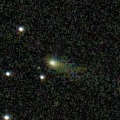
|
Now it is 14.0 mag (Sept. 25, Michael Jager). It is observable at 14-15 mag in excellent condition in autumn.
Date(TT) R.A. (2000) Decl. Delta r Elong. m1 Best Time(A, h)
Oct. 2 0 23.05 -0 38.7 0.743 1.742 175 15.0 23:37 ( 0, 54)
Oct. 9 0 22.00 -1 37.1 0.737 1.727 168 14.9 23:09 ( 0, 53)
|
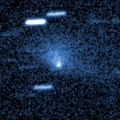
|
It brightened up to 10.1 mag in spring (Apr. 10, Marco Goiato). Now it is fading. It has already faded down to 15.3 mag (Sept. 9, Sandor Szabo). It stays observable in good condition for a long time after this while the comet will fading.
Date(TT) R.A. (2000) Decl. Delta r Elong. m1 Best Time(A, h)
Oct. 2 4 55.60 7 18.8 1.704 2.305 114 14.9 4:13 ( 0, 62)
Oct. 9 4 54.90 6 54.1 1.672 2.349 121 15.0 3:45 ( 0, 62)
|
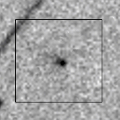
|
Now it is not observable. In the Southern Hemisphere, it will appear in the morning sky at 11 mag in late January, then it stays observable at 11 mag until June. In the Northern Hemisphere, it will appear in the morning sky in December, but it stays locating extremely low for a long time.
Date(TT) R.A. (2000) Decl. Delta r Elong. m1 Best Time(A, h)
Oct. 2 13 11.91 -4 6.3 3.202 2.223 9 15.1 19:06 ( 92,-10)
Oct. 9 13 25.39 -5 28.7 3.169 2.181 6 14.9 18:57 ( 91,-12)
|
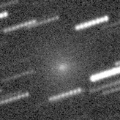
|
Bright new periodic comet. Now it is 13.9 mag (Sept. 15, Michael Jager). It stays observable in good condition for a long time. It stays 14-15 mag until November. Juan Jose Gonzalez reported it is very bright as 11.6 mag on Sept. 17.
Date(TT) R.A. (2000) Decl. Delta r Elong. m1 Best Time(A, h)
Oct. 2 8 46.28 13 13.4 1.497 1.294 58 15.0 4:31 (281, 38)
Oct. 9 9 6.30 10 53.2 1.499 1.322 60 15.1 4:37 (286, 39)
|
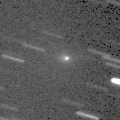
|
Now it is 14.1 mag (Sept. 15, Michael Jager). It stays 15 mag until November. It will be observable in excellent condition in the Northern Hemisphere. It locates somewhat low in the Southern Hemisphere.
Date(TT) R.A. (2000) Decl. Delta r Elong. m1 Best Time(A, h)
Oct. 2 6 16.10 25 13.0 1.257 1.675 95 15.1 4:31 (302, 73)
Oct. 9 6 30.49 26 14.1 1.213 1.685 98 15.1 4:37 (310, 77)
|

|
Now it is 14.8 mag (Sept. 11, Chris Wyatt). It was expected to brighten up to 13 mag from spring to summer. But actually, it is fainter than originally expected. It stays 14-15 mag until early autumn. In the Southern Hemisphere, it stays observable in good condition for a long time. In the Northern Hemisphere, it is not observable until July in 2022.
Date(TT) R.A. (2000) Decl. Delta r Elong. m1 Best Time(A, h)
Oct. 2 20 58.36 -79 47.2 3.527 3.711 92 15.1 20:16 ( 0,-25)
Oct. 9 21 7.75 -78 7.0 3.585 3.727 90 15.2 19:57 ( 0,-23)
|

|
Now it is 15.2 mag (Sept. 8, Chris Wyatt). It stays at 14-15 mag for a long time from 2021 to 2022. It will be unobservable from November to January.
Date(TT) R.A. (2000) Decl. Delta r Elong. m1 Best Time(A, h)
Oct. 2 16 22.01 -18 24.1 5.455 4.999 58 15.2 19:06 ( 52, 17)
Oct. 9 16 23.51 -19 16.5 5.554 4.997 51 15.2 18:57 ( 54, 14)
|
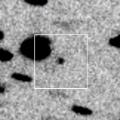
|
It will brighten up to 12 mag from winter to spring. Now it is not observable. In the Northern Hemisphere, it will appear in the morning sky at 14 mag in November. In the Southern Hemisphere, it is not observable until January.
Date(TT) R.A. (2000) Decl. Delta r Elong. m1 Best Time(A, h)
Oct. 2 11 58.34 7 50.4 3.058 2.102 14 15.4 4:31 (257, -5)
Oct. 9 12 12.80 6 12.1 3.000 2.063 16 15.2 4:37 (261, -2)
|

|
Now it is 16.0 mag (Aug. 16, iTelescope Observatory, Siding Spring). It is expected to brighten up to 13 mag in 2022. In the Southern Hemisphere, it stays observable in good condition for a long time, although it becomes extremely low temporarily from September to October. In the Northern Hemisphere, it is not observable for a while.
Date(TT) R.A. (2000) Decl. Delta r Elong. m1 Best Time(A, h)
Oct. 2 12 21.77 -29 14.7 4.856 3.979 25 15.4 4:31 (287,-29)
Oct. 9 12 25.17 -30 27.5 4.819 3.940 25 15.4 4:37 (291,-24)
|
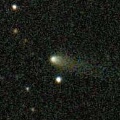
|
Now it is 14.7 mag (Sept. 11, Chris Wyatt). It stays 15 mag until October, and it is observable in good condition.
Date(TT) R.A. (2000) Decl. Delta r Elong. m1 Best Time(A, h)
Oct. 2 23 3.97 -16 21.1 1.375 2.300 150 15.4 22:19 ( 0, 39)
Oct. 9 23 2.69 -16 52.8 1.422 2.303 143 15.5 21:50 ( 0, 38)
|

|
Now it is 15.7 mag (Aug. 30, Thomas Lehmann). In the Northern Hemisphere, it is not observable now. It will be unobservable soon also in the Southern Hemisphere. It will appear in the morning sky at 15 mag in January. Then It will brighten up to 13 mag in 2022 summer.
Date(TT) R.A. (2000) Decl. Delta r Elong. m1 Best Time(A, h)
Oct. 2 14 26.96 -13 3.4 4.154 3.324 29 15.5 19:06 ( 74, 0)
Oct. 9 14 36.16 -13 57.9 4.186 3.312 25 15.5 18:57 ( 75, -3)
|
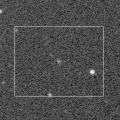
|
Now it is 16.2 mag (Sept. 18, Thomas Lehmann). It will brighten up to 12.5 mag in 2022 summer. In the Southern Hemisphere, it stays observable in excellent condition for a long time. In the Northern Hemisphere, it is not observable until August in 2022.
Date(TT) R.A. (2000) Decl. Delta r Elong. m1 Best Time(A, h)
Oct. 2 3 8.68 -72 22.2 4.177 4.464 100 15.6 2:26 ( 0,-17)
Oct. 9 2 43.48 -74 6.1 4.165 4.418 98 15.5 1:34 ( 0,-19)
|
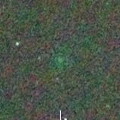
|
It brightened up to 4 mag in major outburst in 2016. In this apparition, it brightened up to 10.5 mag in early August (Aug. 8, Rob Kaufman). Now it is fading rapidly. It has already faded down to 14.0 mag (Aug. 31, Chris Wyatt). In the Southern Hemisphere, it stays locating low in the evening sky until October. In the Northern Hemisphere, it stays locating extremely low.
Date(TT) R.A. (2000) Decl. Delta r Elong. m1 Best Time(A, h)
Oct. 2 15 8.06 -10 53.3 2.117 1.485 39 15.6 19:06 ( 69, 9)
Oct. 9 15 30.65 -12 8.4 2.203 1.547 38 16.2 18:57 ( 68, 9)
|
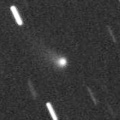
|
Now it is 15.4 mag (Sept. 8, Thomas Lehmann). In the Northern Hemisphere, it stays observable at 15-16 mag for a long time until early 2022, although it becomes extremely low temporarily from September to October. In the Southern Hemisphere, it is not observable until the end of 2021.
Date(TT) R.A. (2000) Decl. Delta r Elong. m1 Best Time(A, h)
Oct. 2 12 53.57 29 34.1 3.820 3.035 33 15.6 19:06 (122, 6)
Oct. 9 12 57.43 27 48.5 3.822 3.045 33 15.7 4:37 (238, 3)
|
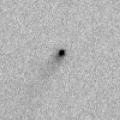
|
Now it is 15.8 mag (Sept. 3, Michael Jager). It will be fading after this, and it will be fainter than 18 mag in December. In the Northern Hemisphere, it stays observable in good condition for a long time. In the Southern Hemisphere, it will be getting lower gradually after this.
Date(TT) R.A. (2000) Decl. Delta r Elong. m1 Best Time(A, h)
Oct. 2 7 23.50 30 12.9 1.420 1.600 80 15.7 4:31 (271, 62)
Oct. 9 7 41.76 31 24.3 1.390 1.623 83 15.9 4:37 (271, 66)
|
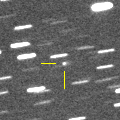
|
Brightening rapidly. Now it is 16.3 mag (Sept. 12, ATLAS-MLO, Mauna Loa). It will be observable at 15 mag in excellent condition in winter.
Date(TT) R.A. (2000) Decl. Delta r Elong. m1 Best Time(A, h)
Oct. 2 7 44.98 24 41.3 2.518 2.458 75 15.9 4:31 (277, 56)
Oct. 9 7 55.15 23 57.7 2.434 2.456 79 15.8 4:37 (283, 60)
|
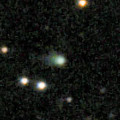
|
Now it is 15.9 mag (Sept. 13, ATLAS-MLO, Mauna Loa). It is expected to brighten up to 11 mag in 2023. In the Northern Hemisphere, it stays observable in good condition for a long time. It is not observable in the Southern Hemisphere.
Date(TT) R.A. (2000) Decl. Delta r Elong. m1 Best Time(A, h)
Oct. 2 16 5.80 37 25.5 6.272 5.905 64 15.8 19:06 (110, 45)
Oct. 9 16 6.66 36 25.7 6.274 5.862 61 15.8 18:57 (110, 42)
|
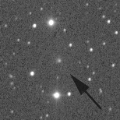
|
It brightened up to 14.2 mag in early summer (June 10, Thomas Lehmann). Now it is fading. In the Northern Hemisphere, it is appearing in the morning sky. In the Southern Hemisphere, it will never be observable again.
Date(TT) R.A. (2000) Decl. Delta r Elong. m1 Best Time(A, h)
Oct. 2 12 6.84 24 11.2 3.016 2.187 28 15.8 4:31 (243, 4)
Oct. 9 12 22.25 25 7.9 3.003 2.225 32 15.9 4:37 (245, 7)
|
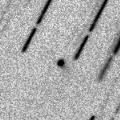
|
Michael Jager detected its cometary activity on Sept. 25. Now it is bright as 16.2 mag (Sept. 25, Michael Jager). It approaches to Earth down to 0.35 a.u. in early October, and it is observable at 16 mag in excellent condition.
Date(TT) R.A. (2000) Decl. Delta r Elong. m1 Best Time(A, h)
Oct. 2 23 56.07 9 30.9 0.353 1.349 169 16.0 23:12 ( 0, 64)
Oct. 9 0 9.25 3 38.3 0.357 1.350 167 16.0 22:57 ( 0, 58)
|
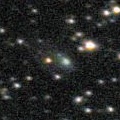
|
Now it is 16.2 mag (Sept. 22, Thomas Lehmann). It is expected to brighten up to 11 mag from spring to summer in 2022. In the Southen Hemisphere, it locates somewhat low in 2021, but it will be observable in good condition at the high light for a long time. In the Northern Hemisphere, it is observable in good condition in 2021, but it will not be observable at the high light.
Date(TT) R.A. (2000) Decl. Delta r Elong. m1 Best Time(A, h)
Oct. 2 18 37.19 15 51.4 3.310 3.494 92 16.0 19:06 ( 45, 65)
Oct. 9 18 35.75 13 27.9 3.349 3.430 86 16.0 18:57 ( 50, 60)
|
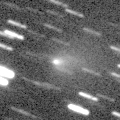
|
Outburst occured in early August. Now it is 15.5 mag (Sept. 23, Thomas Lehmann). In the Northern Hemisphere, it stays observable in good condition. In the Southern Hemipsphere, it stays locating extremely low after this.
Date(TT) R.A. (2000) Decl. Delta r Elong. m1 Best Time(A, h)
Oct. 2 5 52.01 45 18.2 2.299 2.655 99 16.0 4:31 (213, 77)
Oct. 9 5 56.45 46 0.7 2.245 2.683 105 16.2 4:37 (189, 79)
|
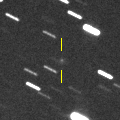
|
Now it is 18.2 mag (Sept. 25, Michael Jager). It will brightens rapidly. And it is expected to be observable at 12-13 mag in good condition from December to February.
Date(TT) R.A. (2000) Decl. Delta r Elong. m1 Best Time(A, h)
Oct. 2 21 48.14 -5 34.9 0.784 1.669 138 16.4 21:03 ( 0, 49)
Oct. 9 21 43.48 -6 47.8 0.774 1.609 129 16.1 20:31 ( 0, 48)
|
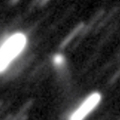
|
Now it is 15.7 mag (Sept. 9, Toshihiko Ikemura, Hirohisa Sato). It will be unobservable in November.
Date(TT) R.A. (2000) Decl. Delta r Elong. m1 Best Time(A, h)
Oct. 2 16 43.83 -9 10.9 5.246 4.870 62 16.1 19:06 ( 54, 28)
Oct. 9 16 47.84 -8 45.5 5.343 4.873 57 16.2 18:57 ( 57, 26)
|
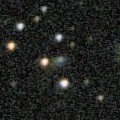
|
Now it is 17.9 mag (Sept. 12, Thomas Lehmann). It will brighten up to 15.5 mag in winter. In the Northern Hemisphere, it stays observable in good condition for a long time. It is not observable at all in the Southern Hemisphere.
Date(TT) R.A. (2000) Decl. Delta r Elong. m1 Best Time(A, h)
Oct. 2 15 39.10 65 18.8 3.278 3.198 76 16.3 19:06 (149, 42)
Oct. 9 15 38.17 64 19.2 3.252 3.172 76 16.3 18:57 (148, 41)
|
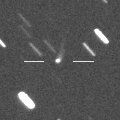
|
It was expected to brighten up to 14.5 mag from spring to summer. But actually, it is fainter than expected. Now it is 17.7 mag (July 4, Mount John Observatory, Lake Tekapo). In the Southern Hemisphere, it stays observable in excellent condition for a long time. In the Northern Hemisphere, it is not observable after this.
Date(TT) R.A. (2000) Decl. Delta r Elong. m1 Best Time(A, h)
Oct. 2 11 21.05 -51 48.5 3.680 3.141 50 16.3 4:31 (316,-28)
Oct. 9 11 28.95 -51 36.8 3.744 3.180 49 16.4 4:37 (317,-24)
|
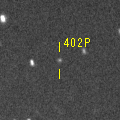
|
First return of a new periodic comet observed at 16 mag from 2003 to 2004. Now it is 17.5 mag (Sept. 5, ATLAS-HKO, Haleakala). It will brighten up to 16 mag in winter, and it will be observable in excellent condition.
Date(TT) R.A. (2000) Decl. Delta r Elong. m1 Best Time(A, h)
Oct. 2 6 32.65 1 26.9 3.833 3.960 89 16.4 4:31 (327, 52)
Oct. 9 6 35.89 1 15.1 3.733 3.956 95 16.3 4:37 (339, 54)
|
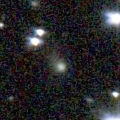
|
Now it is 16.8 mag (Sept. 22, Thomas Lehmann). It is expected to brighten up to 11 mag in 2023. In the Northern Hemisphere, it is observable in good condition in 2021. But it is observable only until November in 2022. In the Southern Hemisphere, it locates extremely low in 2021. But it will be observable in good condition at the high light.
Date(TT) R.A. (2000) Decl. Delta r Elong. m1 Best Time(A, h)
Oct. 2 17 27.46 30 48.1 6.230 6.101 78 16.4 19:06 ( 92, 60)
Oct. 9 17 29.21 29 29.5 6.248 6.053 74 16.4 18:57 ( 92, 56)
|

|
It brightened up to 11.6 mag in winter (Feb. 18, Thomas Lehmann). Now it is fading. It has already faded down to 15.8 mag (Sept. 15, Thomas Lehmann). In the Southern Hemisphere, it stays observable in good condition after this. In the Northern Hemisphere, it will never be observable after this.
Date(TT) R.A. (2000) Decl. Delta r Elong. m1 Best Time(A, h)
Oct. 2 4 22.63 -69 16.5 3.709 3.968 97 16.4 3:40 ( 0,-14)
Oct. 9 4 0.13 -70 2.7 3.773 4.033 97 16.5 2:50 ( 0,-15)
|
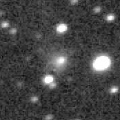
|
Now it is 16.2 mag (Sept. 22, Thomas Lehmann). It is observable at 16 mag from 2020 to 2021. It locates low in the Southern Hemisphere.
Date(TT) R.A. (2000) Decl. Delta r Elong. m1 Best Time(A, h)
Oct. 2 21 45.64 35 6.9 5.439 6.133 130 16.4 21:00 (180, 90)
Oct. 9 21 41.30 33 31.1 5.491 6.145 127 16.4 20:28 ( 0, 89)
|
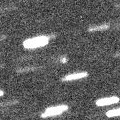
|
Now it is 16.7 mag (Sept. 12, ATLAS-HKO, Haleakala). It stays 16.5 mag until October.
Date(TT) R.A. (2000) Decl. Delta r Elong. m1 Best Time(A, h)
Oct. 2 17 25.99 -20 28.3 1.722 1.726 73 16.4 19:06 ( 37, 25)
Oct. 9 17 44.24 -20 47.8 1.771 1.722 70 16.4 18:57 ( 37, 25)
|
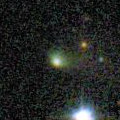
|
Now it is 15.3 mag (Sept. 9, Sandor Szabo). It will be fading after this, and it will be fainter than 18 mag in November.
Date(TT) R.A. (2000) Decl. Delta r Elong. m1 Best Time(A, h)
Oct. 2 1 7.68 -13 13.4 1.920 2.885 161 16.5 0:26 ( 0, 42)
Oct. 9 1 4.49 -13 53.7 1.960 2.918 159 16.7 23:51 ( 0, 41)
|
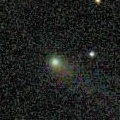
|
Now it is 15.8 mag (Sept. 12, Thomas Lehmann). It stays observable at 16 mag in good condition until October.
Date(TT) R.A. (2000) Decl. Delta r Elong. m1 Best Time(A, h)
Oct. 2 23 0.13 1 13.8 1.229 2.186 156 16.6 22:15 ( 0, 56)
Oct. 9 22 56.95 1 28.0 1.272 2.193 149 16.6 21:44 ( 0, 57)
|
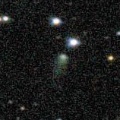
|
Now it is 16.6 mag (Sept. 8, Michael Jager). It stays at 16-17 mag from 2020 to 2021. In the Northern Hemisphere, it stays observable in good condition for a long time. In the Southern Hemisphere, it is not observable after this.
Date(TT) R.A. (2000) Decl. Delta r Elong. m1 Best Time(A, h)
Oct. 2 18 19.66 49 6.1 8.835 8.901 90 16.7 19:06 (137, 68)
Oct. 9 18 19.45 48 42.2 8.879 8.907 88 16.7 18:57 (132, 66)
|
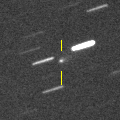
|
Now it is 17.0 mag (Sept. 9, Toshihiko Ikemura, Hirohisa Sato). It stays observable at 17 mag from autumn to winter. In the Northern Hemisphere, it stays observable in good condition. In the Southern Hemisphere, it stays extremely low until November.
Date(TT) R.A. (2000) Decl. Delta r Elong. m1 Best Time(A, h)
Oct. 2 9 38.10 19 46.1 2.273 1.777 48 16.8 4:31 (266, 30)
Oct. 9 9 55.55 18 0.3 2.228 1.778 50 16.7 4:37 (270, 33)
|
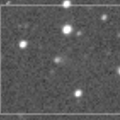
|
First return of a new periodic comet which brightened up to 17 mag in 2006. Now it is 17.4 mag (Sept. 7, J. L. Virlichie, P. Traverse). It stays 17 mag from 2021 to 2022.
Date(TT) R.A. (2000) Decl. Delta r Elong. m1 Best Time(A, h)
Oct. 2 21 29.75 -63 28.6 2.779 3.188 104 16.8 20:45 ( 0, -8)
Oct. 9 21 30.07 -61 47.3 2.827 3.177 101 16.8 20:18 ( 0, -7)
|
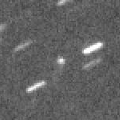
|
Now it is 17.6 mag (Sept. 11, Catalina Sky Survey). It will brighten up to 16 mag in 2022. In the Northern Hemisphere, it stays observable in good condition for a long time. In the Southern Hemisphere, it is not observable until 2023.
Date(TT) R.A. (2000) Decl. Delta r Elong. m1 Best Time(A, h)
Oct. 2 8 50.52 55 45.3 4.334 4.177 74 16.9 4:31 (223, 48)
Oct. 9 8 59.21 57 26.2 4.213 4.151 79 16.8 4:37 (220, 51)
|
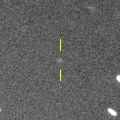
|
Now it is 16.9 mag (Sept. 19, Ken-ichi Kadota). It continues brightening even after the perihelion passage. It stays observable at 17 mag in good condition for a while.
Date(TT) R.A. (2000) Decl. Delta r Elong. m1 Best Time(A, h)
Oct. 2 5 11.52 -13 10.0 3.233 3.678 108 17.0 4:29 ( 0, 42)
Oct. 9 5 11.87 -13 51.6 3.177 3.696 113 16.9 4:02 ( 0, 41)
|

|
Now it is 17.7 mag (May 12, ATLAS-HKO, Haleakala). It brightened rapidly. It stays 17 mag for a long time from 2021 to 2022. In the Southern Hemisphere, it stays observable in good condition for a long time. In the Northern Hemisphere, it will be observable only in extremely low sky from autumn to winter.
Date(TT) R.A. (2000) Decl. Delta r Elong. m1 Best Time(A, h)
Oct. 2 9 6.11 -23 44.9 5.874 5.342 53 17.0 4:31 (308, 9)
Oct. 9 9 7.61 -25 13.2 5.800 5.339 58 17.0 4:37 (314, 13)
|
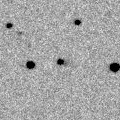
|
Now it is 17.2 mag (Sept. 2, Michael Jager). It is observable at 17 mag in good condition in autumn.
Date(TT) R.A. (2000) Decl. Delta r Elong. m1 Best Time(A, h)
Oct. 2 2 28.75 17 36.3 2.919 3.805 148 17.1 1:47 ( 0, 73)
Oct. 9 2 26.37 17 6.8 2.870 3.803 155 17.1 1:17 ( 0, 72)
|
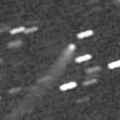
|
Now it is 16.7 mag (Sept. 12, Catalina Sky Survey). Fading slowly. In the Northern Hemisphere, it stays observable in good condition for a long time. It is not observable after this in the Southern Hemisphere.
Date(TT) R.A. (2000) Decl. Delta r Elong. m1 Best Time(A, h)
Oct. 2 16 14.32 49 39.4 6.075 5.833 71 17.2 19:06 (128, 48)
Oct. 9 16 15.68 49 5.2 6.133 5.867 70 17.2 18:57 (127, 46)
|
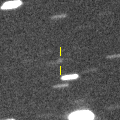
|
Now it is 17.4 mag (Aug. 28, Toshihiko Ikemura, Hirohisa Sato). It will brighten up to 15.5 mag, and will be observable in excellent condition in winter.
Date(TT) R.A. (2000) Decl. Delta r Elong. m1 Best Time(A, h)
Oct. 2 8 57.31 16 4.6 2.398 2.026 56 17.3 4:31 (276, 37)
Oct. 9 9 12.69 15 13.9 2.331 2.019 59 17.2 4:37 (280, 40)
|

|
Peculiar asteroid moving along a cometary orbit. It brightens up to 17 mag from September to October. In the Northern Hemisphere, it is observable in excellent condition. It is not observable in the Southern Hemisphere.
Date(TT) R.A. (2000) Decl. Delta r Elong. m1 Best Time(A, h)
Oct. 2 8 8.78 85 60.0 0.594 1.180 91 17.2 4:31 (184, 38)
Oct. 9 21 25.81 84 49.2 0.679 1.295 99 17.5 20:08 (180, 41)
|
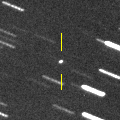
|
Now it is 17.4 mag (Sept. 3, Michael Jager). In the Northern Hemisphere, it stays observable in good condition after this while the comet will be fading. In the Southern Hemisphere, it stays locating extremely low for a long time.
Date(TT) R.A. (2000) Decl. Delta r Elong. m1 Best Time(A, h)
Oct. 2 5 26.26 39 46.9 2.323 2.754 104 17.2 4:31 (208, 85)
Oct. 9 5 27.14 40 29.0 2.291 2.810 111 17.2 4:18 (180, 85)
|
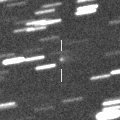
|
Now it is 17.2 mag (Sept. 8, Catalina Sky Survey). In the Northern Hemisphere, it stays observable at 17 mag in good condition until winter. In the Southern Hemisphere, it stays locating extremely low for a while.
Date(TT) R.A. (2000) Decl. Delta r Elong. m1 Best Time(A, h)
Oct. 2 8 12.88 32 22.9 2.119 2.027 70 17.2 4:31 (261, 53)
Oct. 9 8 25.91 31 16.3 2.072 2.049 74 17.3 4:37 (265, 57)
|

|
Now it is 18.1 mag (Sept. 11, ATLAS-HKO, Haleakala). It stays 17 mag for a long time from 2021 to 2022. It is observable in excellent condition in the Northern Hemisphere, It locates somewhat low in the Southern Hemisphere.
Date(TT) R.A. (2000) Decl. Delta r Elong. m1 Best Time(A, h)
Oct. 2 5 22.36 33 36.0 5.166 5.532 106 17.4 4:31 (305, 88)
Oct. 9 5 16.21 33 53.2 5.031 5.519 114 17.3 4:07 ( 0, 89)
|

|
Now it is 17.7 mag (Sept. 9, Toshihiko Ikemura, Hirohisa Sato). It will be fading slowly.
Date(TT) R.A. (2000) Decl. Delta r Elong. m1 Best Time(A, h)
Oct. 2 16 52.22 -10 34.5 8.498 8.123 64 17.3 19:06 ( 51, 28)
Oct. 9 16 52.78 -10 32.0 8.631 8.150 58 17.4 18:57 ( 55, 25)
|

|
Now it is 18.2 mag (Sept. 6, W. Hasubick). It will brighten rapidly, and it will be observable at 13.5 mag in good condition from winter to spring.
Date(TT) R.A. (2000) Decl. Delta r Elong. m1 Best Time(A, h)
Oct. 2 8 46.67 21 16.1 3.249 2.889 60 17.6 4:31 (272, 42)
Oct. 9 8 56.41 20 42.8 3.140 2.864 64 17.4 4:37 (276, 46)
|
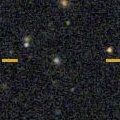
|
Now it is 18.0 mag (Sept. 24, Michael Jager). It is expected to brighten up to 4.5 mag in 2022 April. However, it is not observable at the high light. In the Northern Hemisphere, it stays observable until early February when it brightens up to 14 mag. Then it will appear at 6 mag in mid May, and it stays observable in good condition after that while the comet will be fading. In the Southern Hemisphere, it stays observable until December when it brightens up to 16 mag. But after that, it is not observable until 2022 August.
Date(TT) R.A. (2000) Decl. Delta r Elong. m1 Best Time(A, h)
Oct. 2 22 23.97 22 19.8 2.655 3.512 143 17.6 21:38 ( 0, 77)
Oct. 9 22 16.71 20 41.9 2.612 3.424 138 17.4 21:03 ( 0, 76)
|
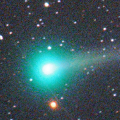
|
It brightened up to 3 mag in December in the SOHO spacecraft images in 2020 December (Dec. 18, Hirohisa Sato). Now it is 16.5 mag (Sept. 5, Thomas Lehmann). It stays observable in good condition after this while the comet will be fading.
Date(TT) R.A. (2000) Decl. Delta r Elong. m1 Best Time(A, h)
Oct. 2 23 22.41 15 10.8 3.530 4.480 159 17.5 22:37 ( 0, 70)
Oct. 9 23 17.66 14 18.1 3.636 4.556 154 17.6 22:04 ( 0, 69)
|

|
Now it is 17.0 mag (Aug. 26, J. Drummond). It will brighten up to 16.5-17 mag in winter. In its last apparition in 2015, it brightened up to 13 mag.
Date(TT) R.A. (2000) Decl. Delta r Elong. m1 Best Time(A, h)
Oct. 2 21 45.80 -33 6.0 1.490 2.234 126 17.6 21:01 ( 0, 22)
Oct. 9 21 44.39 -33 1.7 1.518 2.193 119 17.5 20:32 ( 0, 22)
|
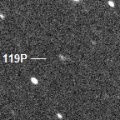
|
Now it is 17.3 mag (Sept. 11, Purple Mountain Observatory, XuYi Station). It will brighten up to 15 mag in 2022 winter. In 2021, it stays observable in good condition while the comet will be brightening gradually.
Date(TT) R.A. (2000) Decl. Delta r Elong. m1 Best Time(A, h)
Oct. 2 22 28.02 -18 59.6 2.241 3.093 142 17.6 21:43 ( 0, 36)
Oct. 9 22 25.17 -19 8.7 2.281 3.067 134 17.6 21:12 ( 0, 36)
|
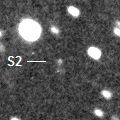
|
First return of a new periodic comet which brightened up to 17 mag in 2012. Now it is 18.1 mag (Aug. 29, ATLAS-MLO, Mauna Loa). It is observable in excellent condition in the Southern Hemisphere. It locates low in the Northern Hemisphere.
Date(TT) R.A. (2000) Decl. Delta r Elong. m1 Best Time(A, h)
Oct. 2 20 15.38 -36 17.7 0.727 1.410 108 17.7 19:32 ( 0, 19)
Oct. 9 20 31.96 -34 23.9 0.736 1.390 105 17.7 19:21 ( 0, 21)
|
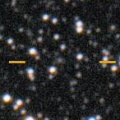
|
Now it is 17.4 mag (Sept. 9, Toshihiko Ikemura, Hirohisa Sato). It stays observable at 17-18 mag for a long time from 2021 to 2022.
Date(TT) R.A. (2000) Decl. Delta r Elong. m1 Best Time(A, h)
Oct. 2 19 11.36 -18 59.1 3.829 4.092 98 17.7 19:06 ( 11, 35)
Oct. 9 19 14.99 -18 57.3 3.928 4.088 92 17.8 18:57 ( 15, 35)
|

|
First return of a new periodic comet which brightened up to 17 mag in 2011. Now it is 17.2 mag (Sept. 16, Catalina Sky Survey). It stays observable at 17 mag in good condition until 2022 spring.
Date(TT) R.A. (2000) Decl. Delta r Elong. m1 Best Time(A, h)
Oct. 2 9 32.52 17 41.8 2.137 1.663 49 17.9 4:31 (269, 31)
Oct. 9 9 52.63 16 12.0 2.076 1.641 50 17.7 4:37 (272, 32)
|
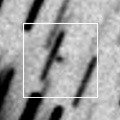
|
Now it is 17.8 mag (Sept. 12, S. Shurpakov). It is expected to brighten up to 11 mag in 2022 summer. In the Northern Hemisphere, it stays observable in good condition until 2022 June when it brightens up to 11 mag. But it is not observable after the high light. In the Souther Hemisphere, it is not observable until 2022 October.
Date(TT) R.A. (2000) Decl. Delta r Elong. m1 Best Time(A, h)
Oct. 2 0 2.49 63 12.1 3.534 4.127 120 17.9 23:16 (180, 62)
Oct. 9 23 47.79 63 20.4 3.443 4.055 121 17.8 22:34 (180, 62)
|
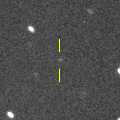
|
Now it is 18.2 mag (Aug. 28, Toshihiko Ikemura, Hirohisa Sato). It has passed the perihelion in 2020 October. At the discovery in 2005, it stayed bright for several years even after the perihelion passage. In this apparition, it may stay observable at 18 mag from 2021 to 2024.
Date(TT) R.A. (2000) Decl. Delta r Elong. m1 Best Time(A, h)
Oct. 2 23 23.13 -29 32.7 3.158 4.004 143 17.8 22:38 ( 0, 26)
Oct. 9 23 20.17 -29 29.3 3.234 4.026 137 17.8 22:07 ( 0, 26)
|
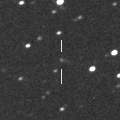
|
Now it is 18.3 mag (Sept. 9, Toshihiko Ikemura, Hirohisa Sato). It will brighten up to 14 mag in early 2023. It stays observable in good condition for a long time until spring.
Date(TT) R.A. (2000) Decl. Delta r Elong. m1 Best Time(A, h)
Oct. 2 4 54.84 3 43.8 5.049 5.538 114 17.9 4:13 ( 0, 59)
Oct. 9 4 54.98 3 29.9 4.914 5.493 120 17.9 3:45 ( 0, 59)
|
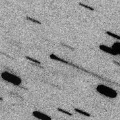
|
Now it is 18.2 mag (Sept. 8, Michael Jager). Main-belt asteroid, but it has a long tail of 10 arcmin (Sept. 4, Michael Jager). It stays observable in good condition until winter.
Date(TT) R.A. (2000) Decl. Delta r Elong. m1 Best Time(A, h)
Oct. 2 23 45.62 -1 34.2 1.498 2.485 167 19.3 23:00 ( 0, 54)
Oct. 9 23 41.25 -2 2.8 1.536 2.495 159 19.5 22:28 ( 0, 53)
|
|
![]()
 28P/Neujmin 1
28P/Neujmin 1 241P/LINEAR
241P/LINEAR C/2020 U4 ( PanSTARRS )
C/2020 U4 ( PanSTARRS ) C/2017 U7 ( PanSTARRS )
C/2017 U7 ( PanSTARRS ) 116P/Wild 4
116P/Wild 4 C/2021 O3 ( PanSTARRS )
C/2021 O3 ( PanSTARRS ) C/2020 S3 ( Erasmus )
C/2020 S3 ( Erasmus ) 230P/LINEAR
230P/LINEAR 119P/Parker-Hartley
119P/Parker-Hartley 424P/2021 L5 ( La Sagra )
424P/2021 L5 ( La Sagra ) 395P/2020 H1 ( Catalina-NEAT )
395P/2020 H1 ( Catalina-NEAT ) 430P/2021 Q2 ( Scotti )
430P/2021 Q2 ( Scotti ) C/2021 P4 ( ATLAS )
C/2021 P4 ( ATLAS ) 378P/2019 E2 ( McNaught )
378P/2019 E2 ( McNaught ) C/2020 S4 ( PanSTARRS )
C/2020 S4 ( PanSTARRS ) 433P/(248370) 2005 QN173
433P/(248370) 2005 QN173![]()







































































